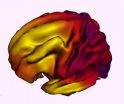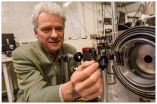'Lightning bolts' in the brain show learning in action
Imaging calcium ion spikes in mouse brains during learning reveals how the brain encodes and stores information
2015-03-30
(Press-News.org) Researchers at NYU Langone Medical Center have captured images of the underlying biological activity within brain cells and their tree-like extensions, or dendrites, in mice that show how their brains sort, store and make sense out of information during learning.
In a study to be published in the journal Nature online March 30, the NYU Langone neuroscientists tracked neuronal activity in dendritic nerve branches as the mice learned motor tasks such as how to run forward and backward on a small treadmill. They concluded that the generation of calcium ion spikes -- which appeared in screen images as tiny "lightning bolts" in these dendrites -- was tied to the strengthening or weakening of connections between neurons, hallmarks of learning new information.
"We believe our study provides important insights into how the brain deals with vast amounts of information continuously as the brain learns new tasks," says senior study investigator and neuroscientist Wen-Biao Gan, PhD.
Gan, a professor at NYU Langone and its Skirball Institute for Biomolecular Medicine, says, "we have long wondered how the brain can store new information continuously throughout life without disrupting previously acquired memories. We now know that the generation of calcium spikes in separate branches of nerve cells is critical for the brain to encode and store large quantities of information without interfering with each other."
Lead study investigator Joseph Cichon, a neuroscience doctoral candidate at NYU Langone, says their discoveries could have important implications for explaining the underlying neural circuit problems in disorders like autism and schizophrenia. Cichon says the team's next steps are to see if calcium ion spikes are malfunctioning in animal models of these brain disorders.
Among the study's key findings was that learning motor tasks such as running forward and backward induced completely separate patterns of lightning bolt-like activity in the dendrites of brain cells. These lightning bolts triggered a chain-like reaction, which changed the strength of connections between neurons.
The study also identified a unique cell type in the brain that controlled where the lightning bolts were generated. When these cells were turned off, lightning bolt patterns in the brain were disrupted, and as a result, the animal lost the information it had just learned.
INFORMATION:
Funding support for the study, which took four years to complete, was provided by National Institutes of Health grants RO1 NS047325 and P01 NS074972.
For more information, go to:
http://skirball.med.nyu.edu/faculty/wenbiao-gan/gan-lab
http://nature.com/articles/doi:10.1038/nature14251
ELSE PRESS RELEASES FROM THIS DATE:
2015-03-30
A lower percentage of children are eating fast food on any given day and calories consumed by children from burger, pizza and chicken fast food restaurants also has dropped, according to an article published online by JAMA Pediatrics.
Colin D. Rehm, Ph.D., M.P.H., formerly of the University of Washington, Seattle, now of the Friedman School of Nutrition Science and Policy at Tufts University, Boston, and Adam Drewnowski, Ph.D., of the University of Washington, Seattle, analyzed data from the National Health and Nutrition Examination Survey from 2003 to 2010 to examine ...
2015-03-30
The medication glyburide, which has been increasingly used to treat gestational diabetes in pregnant women, was associated with higher risk for newborns to be admitted to a neonatal intensive care unit, have respiratory distress, hypoglycemia (low blood glucose), birth injury and be large for gestational age compared with infants born to women treated with insulin, according to an article published online by JAMA Pediatrics.
The prevalence of gestational diabetes mellitus (GDM) in the United States has more than doubled during the last 20 years. Given the widespread and ...
2015-03-30
Turns out, an apple a day won't keep the doctor away but it may mean you will use fewer prescription medications, according to an article published online by JAMA Internal Medicine.
The apple has come to symbolize health and healthy habits. But can apple consumption be associated with reduced health care use because patients who eat them might visit doctors less?
Matthew A. Davis, D.C., M.P.H., Ph.D., of the University of Michigan School of Nursing, Ann Arbor, and coauthors analyzed data from the National Health and Nutrition Examination Survey (2007-2008 and 2009-2010) ...
2015-03-30
Scientists have developed tiny 'nanoneedles' that have successfully prompted parts of the body to generate new blood vessels, in a trial in mice.
The researchers, from Imperial College London and Houston Methodist Research Institute in the USA, hope their nanoneedle technique could ultimately help damaged organs and nerves to repair themselves and help transplanted organs to thrive.
The nanoneedles work by delivering nucleic acids to a specific area. Nucleic acids are the building blocks of all living organisms and they encode, transmit and express genetic information. ...
2015-03-30
Characterizing associations between socioeconomic factors and children's brain development, a team including investigators from nine universities across the country reports correlative links between family income and brain structure. Relationships between the brain and family income were strongest in the lowest end of the economic range - suggesting that interventional policies aimed at these children may have the largest societal impact. The study, led by researchers at The Saban Research Institute of Children's Hospital Los Angeles and Columbia University Medical Center, ...
2015-03-30
A new study has confirmed the existence of a positive feedback operating in climate change whereby warming itself may amplify a rise in greenhouse gases resulting in additional warming.
The study, published in the journal Nature Climate Change, shows that in addition to the well understood effect of greenhouse gases on the Earth's temperature, researchers can now confirm directly from ice-core data that the global temperature has a profound effect on atmospheric greenhouse gas concentrations. This means that as the Earth's temperature rises, the positive feedback in the ...
2015-03-30
Hamilton, ON (March 30, 2015) - Researchers from McMaster University and the Icahn School of Medicine at Mount Sinai, New York have discovered that a protein associated with neurodegenerative diseases like ALS also plays an important role in the body's natural antiviral response.
The study, published today in Nature Immunology, offers new insight into the link between neurodegenerative disorders and inflammation, and provides a framework to explore more fully the possibility that viral infection may lead to onset of these diseases.
Matthew Miller, an investigator at ...
2015-03-30
There are electrical signals in the nervous system, the brain and throughout the human body and there are tiny magnetic fields associated with these signals that could be important for medical science. Researchers from the Niels Bohr Institute have just developed a method that could be used to obtain extremely precise measurements of ultra-small magnetic fields. The results are published in the scientific journal Nature Physics.
The tiny magnetic fields are all the way down on the atomic level. The atoms do not stand still, they revolve around themselves and the axis is ...
2015-03-30
Washington, D.C.-- The 2000-2003 drought in the American southwest triggered a widespread die-off of forests around the region. A Carnegie-led team of scientists developed a new modeling tool to explain how and where trembling aspen forests died as a result of this drought. It is based on damage to the individual trees' ability to transport water under water-stressed conditions.
If the same processes and threshold govern the future, their results suggest that more widespread die-offs of aspen forests triggered by climate change are likely by the 2050s. Tree mortality ...
2015-03-30
Researchers studying cancer and other invasive diseases rely on high-resolution imaging to see tumors and other activity deep within the body's tissues. Using a new high-speed, high-resolution imaging method, Lihong Wang, PhD, and his team at Washington University in St. Louis were able to see blood flow, blood oxygenation, oxygen metabolism and other functions inside a living mouse brain at faster rates than ever before.
Using photoacoustic microscopy (PAM), a single-wavelength, pulse-width-based technique developed in his lab, Wang, the Gene K. Beare Professor of Biomedical ...
LAST 30 PRESS RELEASES:
[Press-News.org] 'Lightning bolts' in the brain show learning in action
Imaging calcium ion spikes in mouse brains during learning reveals how the brain encodes and stores information





